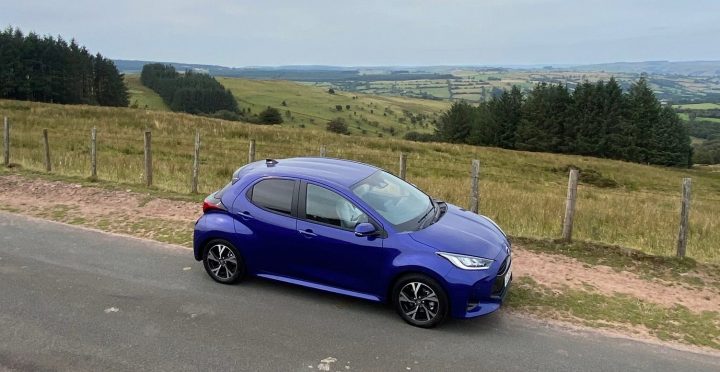The hot-hatch has been reborn for Gen-Z, and there’s a thumbs up from their parents too if they want to enjoy driving a Toyota Yaris hybrid.
The one-time must-have cars for the young drivers of the 1970s seemed to die out in the first decade of this century, but someone forgot to tell Toyota.
 It launched the original Yaris in 1999 and the second generation in 2005, a third six years later and the next in 2020 when it gained an electric hybrid powertrain.
It launched the original Yaris in 1999 and the second generation in 2005, a third six years later and the next in 2020 when it gained an electric hybrid powertrain.
Now it has, literally, been given a big boost with the improved hybrid power to push the busy three-cylinder 1.5 litre petrol engine into a new realm of real-world motoring and enjoyment.
 The latest Yaris comes in four grades or trim levels, Icon, Design, GR Sport and Excel and prices from £23,425 to £29,720 with 114bhp or 129bhp versions of the same triple cylinder 1.5 litre petrol engine with 59 or 62kW electric motor and single continuously variable automatic transmission.
The latest Yaris comes in four grades or trim levels, Icon, Design, GR Sport and Excel and prices from £23,425 to £29,720 with 114bhp or 129bhp versions of the same triple cylinder 1.5 litre petrol engine with 59 or 62kW electric motor and single continuously variable automatic transmission.
We tested the slightly lower powered version in the upper Design trim which brings more standard safety features and improved instrumentation over the entry level Icon, together with full LED lighting all round, rear privacy glass and 16-inch machined alloy wheels.
 Toyota has also carefully revised the driving position to give better control and feedback, and incorporated the latest telephony-mobility and media links.
Toyota has also carefully revised the driving position to give better control and feedback, and incorporated the latest telephony-mobility and media links.
The 114bhp powertrain is the fourth generation of Toyota’s lightweight hybrid system and combines for the first time with the Toyota New Global Architecture platform in the Yaris which not only makes it lighter and stronger but also permits easier tuning for the demands of different countries’ drivers.
 In Britain we tend of appreciate a tauter handling car with sharper responses but expect it to cope with our less smooth roads as well. So it is somewhere between the race-track ready autobahns of Germany and the farm-track routes in the wilderness of France.
In Britain we tend of appreciate a tauter handling car with sharper responses but expect it to cope with our less smooth roads as well. So it is somewhere between the race-track ready autobahns of Germany and the farm-track routes in the wilderness of France.
Toyota has extracted 16% more power, 15% quicker acceleration and sharper responses to the throttle with extended all-electric power for quieter and more economical urban journeys as well.
 This all translates into a better drive whether in town or country with reduced stress on powertrain and driver.
This all translates into a better drive whether in town or country with reduced stress on powertrain and driver.
What we found most remarkable was the fact our petrol fuel consumption never went below 70mpg and frequently hovered towards 100mpg over a mixture of roads.
The triple-pot engine could be a bit noisy when revved or accelerating but it was surprisingly smooth performer nevertheless and remarkably quiet at the motorway maximum.
It easily kept up with urban and main road traffic and on open roads it had a good, useable acceleration envelope for overtaking in safety where permitted.
 The responsiveness of the powertrain, you have power and eco modes to suit situations, was matched with sharp informative steering, light yet strong brakes with struts and beam suspension on 16-inch wheels, a typical sporting package.
The responsiveness of the powertrain, you have power and eco modes to suit situations, was matched with sharp informative steering, light yet strong brakes with struts and beam suspension on 16-inch wheels, a typical sporting package.
The turning circle was tight for town parking and helped with sensors and rear camera while active safety radar automatically slowed if it detected vehicles in line ahead or you entered lower speed limit areas found in its on-board navigation system.
Vision was good to front, sides and back with low waistline, deep windows and powerful washers and big wipers.
All the secondary controls were well laid out close to or on the steering wheel but their clarity was not so good on the fascia. The instruments were very easy to read and customizable to requirements, the air conditioning really worked simply and well.
Oddments provision was a bit tight for a family car and the bootspace was compact if used four/ five up while taller users might find knees crunched into the back of the front seats too.
 Loading the boot was simple with a low lip, wide floor and modest depth beneath the rear glass unless the seat backs were gradually dropped with their 70/30 split into an extended loadbed floor.
Loading the boot was simple with a low lip, wide floor and modest depth beneath the rear glass unless the seat backs were gradually dropped with their 70/30 split into an extended loadbed floor.
Apart from the sometimes busy engine note and regular road rumbles over poor surfaces, the Yaris did not produce much wind or other mechanical noises, so it was very enjoyable on long runs.
Generally, it really coped well with country roads, giving a lot of feedback to what the wheels were doing and where they pointed, soaking up most bumps without too much complaint and never giving a moment’s concern for the car’s grip.
It quickly reminded us of the old hot-hatchbacks, while we appreciated this updated, improved and more civilized version that maybe the last word for Gen-Z.

